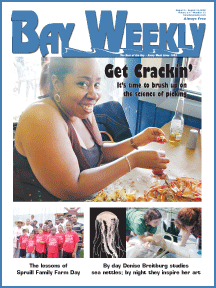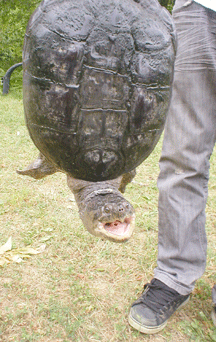
Volume XVII, Issue 32 # August 6 - August 12, 2009 |
 |
 |
Fish Are BitingThe summer rockfish bite on live spot and chum remains steady in the mid-Bay, though bluefish can make things difficult for the live-liners. Breaking rockfish in the mornings and evenings are still being reported from the mouth of the Eastern Bay to the south, with many of them good sized. Big Norfolk spot remain plentiful for anglers during the daylight hours, while croaker are frequently showing up for an evening bite. Large white perch have been absent in any numbers so far this year, while crabbing, though still good in some locations, has fallen off generally. But look for everything to start changing soon: The fall bite is not far away. |
Like a Steel-Belted Radial
Cooking up a taste of times past
Once upon a time, during a past life, I worked in Washington, D.C., near the Main Street Seafood Market off of the Potomac River. Often, friends and I would eat at a restaurant located there, and I would invariably order the specialty of the house, Snapper Turtle Soup. It was delicious, and I promised myself that one day I would make my own.
Last week I finally got the opportunity. While crabbing on the Magothy, I ran into a friend who had just captured a big snapping turtle. He had attempted to shoo the beast off of his trotline with a crab net, but the critter had merely charged the net’s wire basket and become entangled. He offered the turtle to me for my soup project.
The next day, the many people that I consulted assured me that preparing turtle was quite simple and that a snapper had delicious meat. I got the nagging feeling that something was going unsaid. I discovered only later that virtually none of them had ever cooked a snapping turtle.
Dispatching the reptile was uneventful, and after scalding it whole for 20 minutes in a large cauldron of boiling water, per instructions, I separated the meat from the shell. Skinning out and boning the turtle meat turned out to be a messy but simple operation. The rest of the project was a full day’s labor.
|
|
![]() Browning the turtle bones in the oven, I began to prepare the stock. Adding beef broth and a bit of chicken broth to two quarts or so of water, I simmered the bones for about two hours and got the start of a very flavorful liquor. I then removed the bones and added about three cups of diced tomatoes while the broth continued to cook.
Browning the turtle bones in the oven, I began to prepare the stock. Adding beef broth and a bit of chicken broth to two quarts or so of water, I simmered the bones for about two hours and got the start of a very flavorful liquor. I then removed the bones and added about three cups of diced tomatoes while the broth continued to cook.
Chopping the turtle meat into small pieces, I thoroughly browned them in butter and olive oil and set them aside. Adding chopped Spanish onions, green onions, celery, bay leaf, garlic, fresh rosemary, thyme, some Cajun spices and salt and pepper to the broth, I allowed it to slowly absorb the flavors for another hour. Then I added the sautéed turtle meat.
After simmering the whole affair for four more hours, I prepared a roux of butter and flour in a saucepan, caramelizing the mixture to a light brown color before adding it, giving the stock a thick, luscious texture and color.
I finally sampled the finished brew. The first sip of the broth instantly transported me back years ago to that restaurant on the Potomac. I had duplicated the flavor that had remained in my memory all that time.
Proof of the Pudding
I ladled out a bowl of the soup to each of the members of my family, by now clustered around the large, aromatic stockpot.
Flushed with pride, I settled down to the table with the others and dug in. First I sampled some vegetables and the white turtle meat. They melted in my mouth. Then I spooned up a larger piece of turtle, the darker, brown meat that comprised the bulk of the soup.
The flavor was incredible, but it was inedible. It had the consistency of a steel-belted radial, and this was after slow-cooking for over five hours. Yikes.
My poor family continued to chew steadily and unsuccessfully while avoiding my eyes. Finally and mercifully, everyone agreed that the soup was delicious but perhaps underdone.
The next day I simmered the remains of the soup for another five hours. This time the turtle, instead of chewing like a steel-belted radial, merely chewed like a regular radial. The meat remained inedible.
The turtle had gotten its revenge, but I learned my lesson. I would henceforth avail myself of only the prepared, canned variety of snapper soup. These big, wild Chesapeake Bay turtles were forever safe from me. They were every bit as tough as they looked and, as I found out last week, that is very tough indeed.
© COPYRIGHT 2009 by New Bay Enterprises, Inc. All rights reserved.
